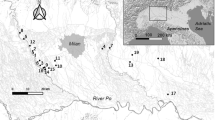Summary
Changes in the frequency of individual species, and in the species composition of the vegetation were monitored at monthly intervals at four stations on the shore of Lake Chilwa. The stations formed a transect from land to lake through the littoralTypha swamp. The relationships between seasonal changes in the frequency of individual species and fluctuations in water level were shown. Stand distance indices decreased from land to lake whilst species diversity decreased from land to the central swamp and then rose again on the lake edges. Seasonal changes in the vegetation were more pronounced on the landward edge, which was subjected to alternate wet and dry periods than in the vegetation of the lake edge. The reasons for these spatial and temporal changes are discussed. It is suggested that plant communities occurring in a fluctuating physical environment may behave differently with respect to diversity from those in which the environment is temporally stable.
Zusammenfassung
An 4 Probestellen am Ufer des Chilwa-Sees wurde monatlich die Frequenz jeder Art und die Artenzusammensetzung in der Vegetation bestimmt. Die Probestellen stellten ein Profil vom Land seewärts durch den litoralenTypha-Sumpf dar. Die Beziehungen zwischen dem jahreszeitlich bedingten Wechsel der einzelnen Arten und den Wasserstandsschwankungen werden aufgezeigt. Für jede Probestelle wurde ein ‘distance index’ und ein Diversitätsindex berechnet. Der ‘distance index’ nahm in Richtung See ab, während der Diversitätsindex bis zum zentralen Teil des Sumpfes ebenfalls abnahm, dann jedoch bis zur offenen Seefläche hin anstieg. Die saisonbedingten Veränderungen der an der Vegetation untersuchten Parameter waren, bedingt durch eine 3–4 monatige Trockenphase, in den landwärts gelegenen Probestellen stärker als in den seewärts gelegenen.
Die Gründe für diese räumlich und zeitlich bedingten Veränderungen werden diskutiert. Es wird vermutet, dass die Artendiversität in Pflanzengesellschaften, die dort vorkommen, wo die Umweltfaktoren saisonbedingt variieren stark beeinflusst wird. Um die Diversität auf die Umweltfaktoren zu beziehen, ist es daher nötig, diese Faktoren zu unterschiedlichen Zeiten zu bestimmen.
Similar content being viewed by others
References
Brown, L. 1965. Africa, a natural history. Hamish Hamilton, London. 299 pp.
Greig-Smith, P. 1964. Quantitative plant ecology. 2nd ed. Butterworth & Co., London. XII + 256 pp.
Grime, J. P. 1973. Competitive exclusion in herbaceous vegetation. Nature, London 242: 344–347.
Hejný, S. 1971. The dynamic characteristic of littoral vegetation with respect to changes in water level. Hidrobiologia Bucur. 12: 71–86.
Howard-Williams, C. 1972. Limnological studies in an African swamp: Seasonal and spatial changes in the swamps of Lake Chilwa, Malawi. Arch. Hydrobiol. 70: 379–391.
Howard-Williams, C. & B. H. Walker. 1974. The vegetation of a tropical African lake: Classification and ordination of the vegetation of Lake Chilwa (Malawi). J. Ecol. 62: 831–854.
Junk, W. J. 1970. Investigations on the ecology and production biology of the ‘floating meadows’ (Paspalo-Echinochloetum) on the Middle Amazon. I. The floating vegetation and its ecology. Amazoniana 2: 449–495.
Maarel, E. van der. 1966. Dutch studies on coastal sand dune vegetation, especially in the Delta region. Wentia 15: 47–82.
Maarel, E. van der & J. Leertouwer. 1967. Variation in vegetation and species diversity along a local environmental gradient. Acta Bot. Neerl. 16: 211–221.
Magadza, C. H. D. 1970. A preliminary survey of the vegetation of the shore of Lake Kariba. Kirkia 7: 253–267.
McIntosh, R. P. 1967. An index of diversity and the relation of certain concepts to diversity. Ecology 48: 392–404.
McLachlan, A. J., P. R. Morgan, C. Howard-Williams, S. M. McLachlan & D. Bourn. 1972. Aspects of the recovery of a saline African lake following a dry period. Arch. Hydrobiol. 70: 325–340.
Mitchell, D. S. 1969. The ecology of vascular hydrophytes on Lake Kariba. Hydrobiologia 34: 448–464.
Morgan, A. & M. Kalk. 1970. Seasonal changes in the waters of Lake Chilwa (Malawi) in a drying phase, 1966–1968. Hydrobiologia 36: 81–103.
Moss, B. & J. Moss. 1969. Aspects of the limnology of an endorheic African lake (L. Chilwa, Malawi). Ecology 50: 109–118.
Odum, E. P. 1963. Ecology. Holt, Rhinehart & Winston, New York. VII + 152 pp.
Segal, S. 1971. Principles on structure, zonation and succession of aquatic macrophytes. Hidrobiologia Bucur. 12: 89–96.
Taylor, P. 1964. The genus Utricularia L. (Lentibulariaceae) in Africa (south of the Sahara) and Madagascar. Kew Bulletin 18: 1–245.
Vesey-Fitzgerald, D. F. 1970. The origin and distribution of valley grasslands in East Africa. J. Ecol. 58: 51–75.
Walker, B. H. & R. T. Coupland. 1968. An analysis of vegetation-environment relationships in Saskatchewan sloughs. Can. J. Bot. 46: 509–522.
Author information
Authors and Affiliations
Additional information
For nomenclature of plant species see Table 2.
This work, forming part of a Ph. D. thesis for the University of London, was done while I was working with the Lake Chilwa Co-ordinated Research Project at the University of Malawi. The project was funded by the Leverhulme Foundation, the IBP and the University of Malawi. I am very grateful to Professor M. Kalk, Director of the project, for her continual support. My sincere thanks also to my wife Wendy who helped collect the data, Professor P. Greig-Smith for statistical advice, and Dr. R. S. Clymo and Professor M. Kalk for commenting on the manuscript.
Rights and permissions
About this article
Cite this article
Howard-Williams, C. Seasonal and spatial changes in the composition of the aquatic and semiaquatic vegetation of Lake Chilwa, Malawi. Plant Ecol 30, 33–39 (1975). https://doi.org/10.1007/BF02387875
Accepted:
Issue Date:
DOI: https://doi.org/10.1007/BF02387875




